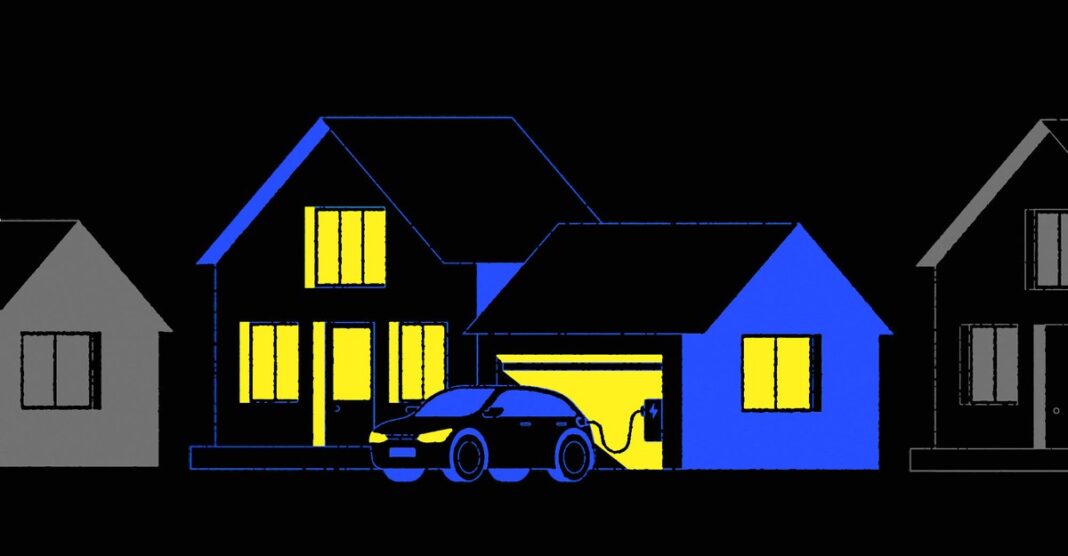When Hurricane Helene knocked out the power in Charlotte, North Carolina, on Friday, Dustin Baker, like many other people across the Southeast, turned to a backup power source. His just happened to be an electric pickup truck. Over the weekend, Baker ran extension cords from the back of his Ford F-150 Lightning, using the truck’s battery to keep his refrigerator and freezer running. It worked so well that Baker became an energy Good Samaritan. “I ran another extension cord to my neighbor so they could run two refrigerators they have,” he told me.
Americans in the heart of hurricane territory have long kept diesel-powered generators as a way of life, but electric cars are a leap forward. An EV, at its most fundamental level, is just a big battery on wheels that can be used to power anything, not just the car itself. Some EVs pack enough juice to power a whole home for several days, or a few appliances for even longer. In the aftermath of Helene, as millions of Americans were left without power, many EV owners did just that. A vet clinic that had lost power used an electric F-150 to keep its medicines cold and continue seeing patients during the blackout. One Tesla Cybertruck owner used his car to power his home after his entire neighborhood lost power.
This feature, known as bidirectional charging, has been largely invisible during America’s ramp-up to electric driving. Many of the most popular EVs in the United States, such as Tesla’s Model Y and Model 3, don’t have it. “It just wasn’t a priority at the time,” a Tesla executive said last year about why the cars lack the feature, though the newly released Cybertruck has bidirectional charging and the company plans to introduce it into its other vehicles in 2025. Bidirectional charging is hardly perfect: Connecting your car to your home requires thousands of dollars of expensive add-on infrastructure and might require pricey upgrades to run extra wiring or upgrade an electrical panel. The Ford Charge Station Pro, which connects the all-electric Ford F-150 to the home’s electricity system, costs about $1,300.
But Hurricane Helene is revealing the enormous potential of bidirectional charging. A new EV doesn’t come cheap, of course, but it has plenty of clear upside over a traditional generator. The latter usually burns diesel, giving off fumes that can kill people who don’t realize that it needs to be kept outdoors; an EV sits silently in the garage, producing zero emissions as it conquers a power outage, even a lengthy one. “I lost a total of about 7 percent of my capacity,” Baker said. “Doing the math, I estimated I could get almost 2 weeks of running my freezer and refrigerator.” Plus, there’s no need to join the hurricane rush to the gas station if your vehicle runs on electricity. In Asheville, which has been especially devastated by flooding, residents have struggled to find gas for their cars.
This resiliency in case of power outages was a major reason Jamie Courtney, who lives in Prairieville, Louisiana, decided to go electric. When Hurricane Francine slammed Louisiana last month, Courtney hadn’t yet connected his Tesla Cybertruck to his home power supply. So, like Baker, he MacGyvered a fix: Courtney ran cords from the outlets located in the truck’s bed into his house to power a variety of appliances during a blackout. “We were able to run my internet router and TV, [plus] lamps, refrigerator, a window AC unit, and fans, as well as several phone, watch, and laptop chargers,” he told me. Over the course of about 24 hours, he said, all of this activity ran his Cybertruck battery down from 99 percent to 80 percent.
As a new generation of EVs (including Teslas) comes standard with bidirectional charging, the feature may become a big part of the pitch for going electric. From a consumer’s point of view, energy has always moved in one direction. People buy gasoline from the service station and burn it; they buy electricity from the power company and use it. But in an electrified world in which cars, stoves, and heating systems run on electricity rather than on fossil fuels, ordinary people can be more than passive consumers of energy. Two-way charging is not just helpful during hurricanes—you might also use some of the energy to run a stereo or power tools by plugging them into the power outlets in the truck’s bed. People have even used EV pickup trucks to power their football tailgates.
Bidirectional charging may prove to be the secret weapon that sells electrification to the South, which has generally remained far behind the West and the Northeast in electric-vehicle purchases. If EVs become widely seen as the best option for blackouts, they could entice not just the climate conscious but also the suburban dads in hurricane country with a core belief in prepping for anything. It will take a lot to overcome the widespread distrust of EVs and anxiety about a new technology, but our loathing of power outages just might do the trick.




